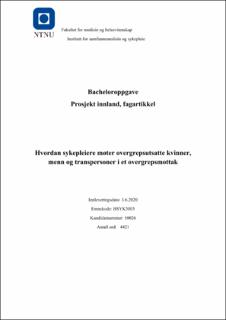| dc.contributor.advisor | Andre, Beate | |
| dc.contributor.author | Malum, Malin | |
| dc.date.accessioned | 2020-07-17T16:02:06Z | |
| dc.date.available | 2020-07-17T16:02:06Z | |
| dc.date.issued | 2020 | |
| dc.identifier.uri | https://hdl.handle.net/11250/2669522 | |
| dc.description.abstract | Introduksjon:
Denne studien har den hensikt å utforske hvordan sykepleiere møter overgrepsutsatte kvinner, menn og transpersoner i et overgrepsmottak. Fagartikkelen tar for seg hvordan sykepleiere møter kvinner, menn og transpersoners reaksjoner og behov i etterkant av et overgrep. Artikkelen drøfter funn i lys av faglig forankret forskning, litteratur og lovverk.
Metode:
For å få innsikt i informantenes opplevelser er det valgt en kvalitativ metode. Det ble gjennomført 8 semistrukturerte intervju med sykepleiere som jobber ved et overgrepsmottak i Norge. Intervjuene ble gjennomført våren 2020. Datamaterialet ble analysert ved bruk av en kombinasjon av meningskoding, meningsfortetning og meningsfortolkning.
Resultat:
Studien finner at informantene møter pasientene med respekt og verdighet, med hensyn til at pasienten er hudløs og sårbar. Informantene møter pasienten med tid til informasjon og tydeliggjøring av at alt skjer på pasientens premisser. Dette gjøres for å gi pasienten en følelse av makt og unngå å utsette dem for nye krenkelser eller følelse av overgrep. Informantene understreker at helsehjelp ytes uavhengig av kjønn, med hensyn til de utfordringene og belastningene et overgrep kan medføre, særlig hos menn og transpersoner. Utgangspunktet for sykepleien som gis er pasientens egen opplevelse, snarere enn hva sykepleieren opplever som sant eller ikke. I situasjoner hvor informanter har opplevd å ikke tro eller tvile på pasientens fortelling, poengteres det at helse og trygghet er utgangspunkt for hvordan sykepleierne møter overgrepsutsatte kvinner, menn og transpersoner.
Konklusjon:
Studien belyser noe av den brede kunnskapen og kompetansen informantene har i møte med kvinner, menn og transpersoner som er utsatt for seksuelle overgrep. Informantene fremstår å være bevisst sitt etiske og juridiske ansvar, og reflekterer rundt utfordringer som kan oppstå. Pasientens forståelse av egen situasjon, er utgangspunktet for helsehjelpen og omsorgen som gis, uten at sykepleier forsøker å avklare pasientens «sannhet». Med dette finner studien at informantene møter sine pasienter med respekt, verdighet og hensyn til hvert enkelt menneskes reaksjoner og behov. Funn fra studien kan tyde på at fremtidig forskning bør inkludere et større utvalg, blant annet menn og transpersoner. | |
| dc.description.abstract | Introduction:
The aim of this study is to explore how nurses encounter sexually assaulted women, men and transgender people at a sexual assault referral center (SARC) in Norway. The article deals with the subjects regarding how nurses meet the patients reactions and needs, in the aftermath of sexual assault.
Method:
In order to gain insight in the participants ‘descriptions and experiences from working at a SARC, a qualitative method had been chosen. Eight semi-structured interviews with the nurses working at the SARC, were conducted during the spring of 2020. The data was analyzed using a combination of coding, condensation and interpretation of meaning units.
Result:
The study finds that the participants encounter the patients with respect and dignity, with awareness of the patients being in a state of crisis and vulnerability. Several participants emphasize time for information and clarification of the fact that everything will be conducted on the patients premises. This is reasoned with the participants intention of giving the patient a sense of power, in order to create a relation, trust and provide safety. This is further reasoned in avoiding exposing the patient to a new sense of trauma or offense. The participants emphasize that health care is provided regardless of gender or gender identity, considering to the challenges and hassles an abuse can cause, especially in men and transgender people. The basis of the care that is provided, is consideration for the patient’s own understanding of their experience, rather than what the nurses experience to be true or not. In situations where informants have experienced not believing, or doubting the patient's narrative, it is again emphasized that healthcare and care are the basis how nurses encounter sexually abused women, men and transgender people.
Conclusion:
The study highlights some of the broad knowledge and competence the informants have as they approach women, men and transgender people who are sexually assaulted. The informants appear to be conscious of their ethical and legal responsibilities, and reflect on challenges that may arise. The patient's own understanding is the basis of the health care and care provided, without the nurse attempting to clarify the patient's "truth". With this, the study finds that the informants meet their patients with respect, dignity and with regarding to the reactions and needs of each individual. Findings from the study may indicate that future research should include a larger sample, including men and transgender people. | |
| dc.publisher | NTNU | |
| dc.title | Hvordan sykepleiere møter overgrepsutsatte kvinner, menn og transpersoner i et overgrepsmottak | |
| dc.type | Bachelor thesis | |
